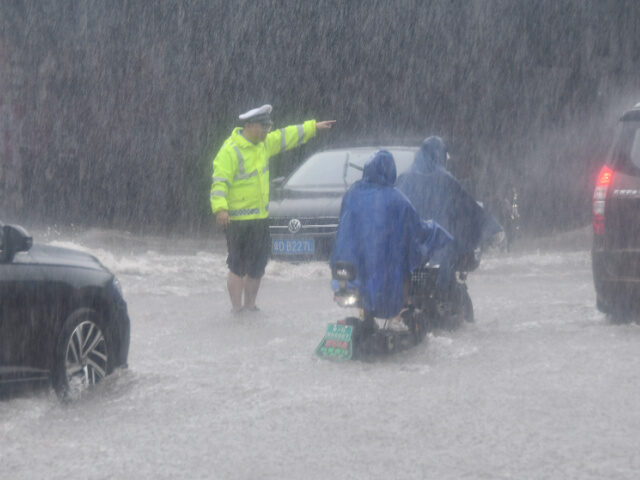Heavy rains from Typhoon Doksuri flooded western Beijing on Monday, forcing more than 30,000 people to evacuate. At least two fatalities were reported in the district of Mentougou, where the worst flooding occurred.
Chinese meteorologists said Doksuri was the worst storm to hit Beijing and northern China in more than a decade, bringing high winds and massive rainfall to the region. Parts of suburban Beijing experienced almost six inches of rain in a matter of hours, while parts of Hebei province reported over 20 inches:
Heavy rainfall is expected to continue in Typhoon Doksuri’s wake until Wednesday, and meteorologists are nervously watching a tropical storm that could become another typhoon early next week. Beijing is expected to see more rain than the devastating July 2012 storm, which flooded parts of the city and killed 79 people.
City and provincial officials said they were better prepared for this week’s massive storm, having learned from the 2012 disaster. Pumps and other emergency equipment were in position before the typhoon struck Beijing, and evacuations were ordered sooner than in 2012.
The flooding in Beijing was severe enough to sweep cars away like toys, shutting down hundreds of roads and prompting some 31,000 evacuations in the Beijing metropolitan area. The 65-mile-long railway connecting Beijing with the city of Shacheng in Hebei suffered “serious water damage,” requiring the evacuation of 2,000 passengers and crew.
Two lingering concerns for regional officials are structural damage to buildings from the floods and damage to crops. The damage to agriculture is especially troubling with another typhoon potentially on the way.
China’s state-run Global Times reported an elevated risk of “geological disasters such as collapses, landslides and mudslides” from the heavy rains, potentially exacerbating the plight of people who sought refuge from the floods on higher ground.
“Two river basins in Fangshan district have overflowed their banks, and there are many dangerous situations along the river. On Monday morning, a road near a village in Fangshan was washed away, blocking access to the village,” the Global Times said.
Although Chinese media discussed only two fatalities occurring for unspecified reasons, the New York Times (NYT) on Tuesday reported the death toll since the weekend has risen to 11, including two rescue workers. Another 27 people are missing.
Flooding struck suburban Beijing so suddenly that some of those cars swept away by torrents of muddy water had people trapped inside them. One Chinese television network broadcast footage of rescue workers lowering themselves on cables into fast-moving flood waters to rescue people who were trapped in their cars:
The pro-communist NYT suggested the high level of preparedness for Typhoon Doksuri was partly due to Chinese officials smarting from criticism of their poor response to the 2012 storm. The Chinese public widely suspects their government lied about the number of fatalities in the previous storm because many of the deaths were caused by delayed evacuation notices and subpar drainage systems in the most heavily flooded districts.
“Beijing has a population of 22 million and the extra resources that come from serving as the nation’s capital. But the expansion of the city has shrunk natural drainage areas, sending overflow onto roads and into neighborhoods,” the NYT observed.

COMMENTS
Please let us know if you're having issues with commenting.